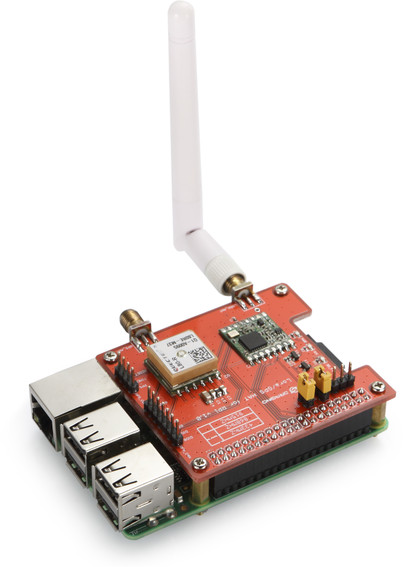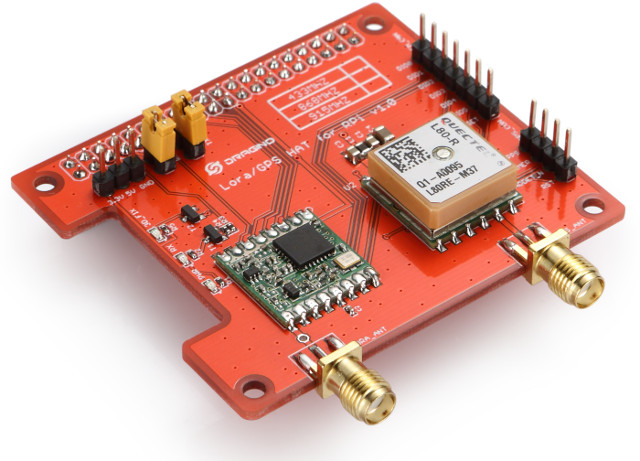There are several ways to play with LoRaWAN protocol on the Raspberry Pi including RisingHF Discovery kit or Cooking Hacks LoRa Shield for Raspberry Pi, but the latter requires you to spend close to $100 just for the shield, the complete Lora discovery kit costs close to $400. Dragino Tech LoRa/GPS HAT board should be a more cost effective way to get started with LoRa on Raspberry Pi, as it sells for $32 + shipping on Tindie.
Dragino LoRa/GPS HAT specifications:
- Connectivity
- LoRa
- Semtech SX1276/SX1278 transceiver @ 433/868, or 915 MHz (Country dependent, pre-configured in the factory)
- 168 dB maximum link budget.
- +20 dBm – 100 mW constant RF output vs. +14 dBm high efficiency PA.
- Programmable bit rate up to 300 kbps.
- GPS
- L80 GPS module based on Mediatek MT3339 SoC
- Horizontal Position Accuracy: autonomous <2.5 m CEP.
- TTFF@-130dBm with EASY (AGPS): Cold Start <15s,Warm Start <5s,Hot start <1s;
- TTFF@-130dBm without EASY (AGPS):Cold Start <35s,Warm Start <30s,Hot Start <1s.
- Timing Accuracy:1PPS out 10ns,Reacquisition Time <1s.
- GPS automatic switching between internal patch antenna and external active antenna
- LoRa
- Built-in temperature sensor and low battery indicator
- Low power consumption (no specific data)
- Dimensions – 60 x 53 x 25 mm; HAT compliant with Raspberry Pi 2 Model B/Raspberry Pi 3.
- Weight – 30g
The package includes the HAT board, 4x brass spacers, 4x screws, 4x nuts, and an external antenna suitable for 433, 868, or 915 MHz as needed.

The board also comes with some apparently decent documentation explaining how to use both LoRa and GPS with the Raspberry Pi 2 or 3, as well as links to schematics (PDF), and other technical documentation. Some typical applications of such board include automated meter reading, home and building automation, wireless alarm and security systems, industrial monitoring and control, and long range irrigation systems.
Beside Tindie, the board can also be purchased on Eleduino for $39 shipped, and by the end of this article, I’ve also come across an even cheaper Dragino Lora Shield for Arduino (433 MHz) selling for $19 on Seeed Studio. More details can also be found in Dragino Tech LoRa/GPS HAT page.

Jean-Luc started CNX Software in 2010 as a part-time endeavor, before quitting his job as a software engineering manager, and starting to write daily news, and reviews full time later in 2011.
Support CNX Software! Donate via cryptocurrencies, become a Patron on Patreon, or purchase goods on Amazon or Aliexpress






How long distance working this? (point to point?)
@Jesu
Long range, but low data rate. From the Semtech data sheet: Using Semtech’s patented LoRa (TM) modulation technique SX1276/77/78/79 can achieve a sensitivity of over -148dBm using a low cost crystal and bill of materials. The high sensitivity combined with the integrated +20 dBm power amplifier yields industry leading link budget making it optimal for any application requiring range or robustness.
Run your own link budget, or see the discussion here:
http://openlora.com/forum/viewtopic.php?f=12&t=119
Or try the simple range calculator on this page:
http://www.link-labs.com/symphony/
I see posts claiming 100-300 meters indoors at 868 MHz with PCB or chip antennas at each end, a kilometer or two clear path line-of-sight with slightly better (rubber duck) antennas. 915 MHz should be similar. 433 MHz may be better indoors but bigger antennas needed. Remember this is low rate with optimum range settings. Theoretically, with elevated high gain antennas 10’s of kilometers is doable line-of-sight.
@Jesu
LoRa is supposed to support several kilometers range, but I can’t find specific info for that board.
Don’t forget, Dragino Tech has a $20 version without the GPS. See Here:
https://www.tindie.com/products/edwin/lora-shield-long-distance-wireless-433868915mhz-/
@cnxsoft
The Dragino boards use the Semtech SX1276/SX1278 chips (link to data-sheet in OP). 1-3 km is easily possible at low rate, with optimal settings, reasonable omni antennas (~0dBd), and clear-path line of sight. Indoors much less, maybe 100-300 meters. These are 868 MHz numbers I’ve seen. See my detailed comment above on range once it is (hopefully) released from moderation. I don’t own any LoRa radios yet, but hope to soon.
@Drone
That model is already discussed in the article. It’s for Arduino though.
Cool! Is this the least expensive and/or easiest to install GPS device for the R Pi?
Not sure what I would use the LoRa for i.e. antenna/receiver needed? HAM license required?
@darethehair
You can get as low to $6 to $10 for a GPS module -> http://www.cnx-software.com/2016/01/04/navspark-mini-is-a-6-arduino-compatible-gps-board/, not in HAT form factor though.
They also have an RPi shield for Navspark (not mini) board @ https://www.tindie.com/products/imrehg/navspark-shield-for-raspberry-pi/.
I understand LoRa uses free-license bands, so a license is not required. Of course, legal stuff depend on the country, so better check with local authorities about the band (433/868/915 MHz) you’d have to use.